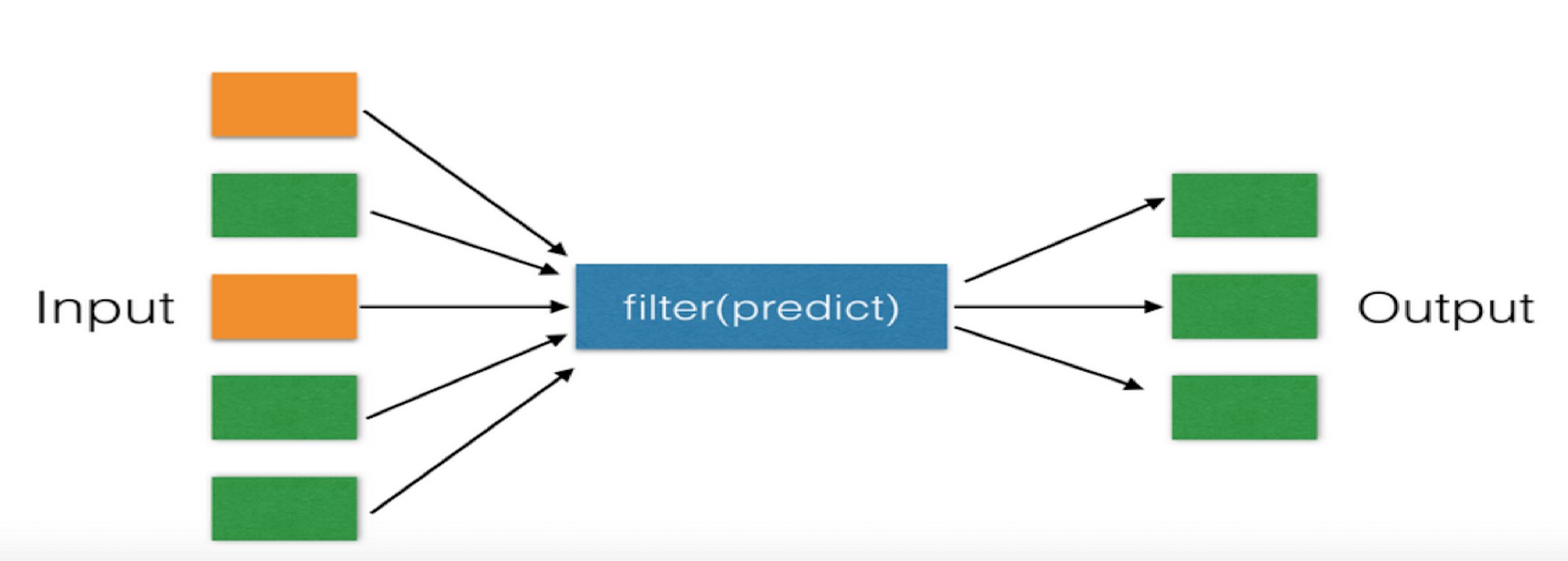内置函数--map,filter,reduce
一、map
class map(object):
"""
map(func, *iterables) --> map object Make an iterator that computes the function using arguments from
each of the iterables. Stops when the shortest iterable is exhausted.
"""
def __getattribute__(self, *args, **kwargs): # real signature unknown
""" Return getattr(self, name). """
pass def __init__(self, func, *iterables): # real signature unknown; restored from __doc__
pass def __iter__(self, *args, **kwargs): # real signature unknown
""" Implement iter(self). """
pass @staticmethod # known case of __new__
def __new__(*args, **kwargs): # real signature unknown
""" Create and return a new object. See help(type) for accurate signature. """
pass def __next__(self, *args, **kwargs): # real signature unknown
""" Implement next(self). """
pass def __reduce__(self, *args, **kwargs): # real signature unknown
""" Return state information for pickling. """
pass
map(func, *iterables) --> map object
Make an iterator that computes the function using arguments from
each of the iterables. Stops when the shortest iterable is exhausted.
"""
使用从参数来计算函数的迭代器每个迭代项。在最短的迭代结束时停止。
遍历序列,对序列中每个元素进行操作,最终获取新的序列。

给li = [1,2,3,4]每个元素加100
#!/usr/bin/python3 li = [1,2,3,4] newList = map(lambda x:x+100, li)
print(newList)
print(list(newList))
执行结果:
<map object at 0x00000000027C4C88>
[101, 102, 103, 104]
参数传入自定义函数:
#!/usr/bin/python3 li = [1,2,3,4] def myAdd (x):
return x * 100 newList = map(myAdd, li)
print(newList)
print(list(newList))
执行结果:
<map object at 0x00000000022249B0>
[100, 200, 300, 400]
二、filter
class filter(object):
"""
filter(function or None, iterable) --> filter object Return an iterator yielding those items of iterable for which function(item)
is true. If function is None, return the items that are true.
"""
def __getattribute__(self, *args, **kwargs): # real signature unknown
""" Return getattr(self, name). """
pass def __init__(self, function_or_None, iterable): # real signature unknown; restored from __doc__
pass def __iter__(self, *args, **kwargs): # real signature unknown
""" Implement iter(self). """
pass @staticmethod # known case of __new__
def __new__(*args, **kwargs): # real signature unknown
""" Create and return a new object. See help(type) for accurate signature. """
pass def __next__(self, *args, **kwargs): # real signature unknown
""" Implement next(self). """
pass def __reduce__(self, *args, **kwargs): # real signature unknown
""" Return state information for pickling. """
pass
filter(function or None, iterable) --> filter object
Return an iterator yielding those items of iterable for which function(item)
is true. If function is None, return the items that are true.
"""
返回一个迭代器,该迭代器可以为该函数(项)进行迭代是真的。如果函数是None,返回true的项。
对于序列中的元素进行筛选,最终获取符合条件的序列
#filter第一个参数为空,将获取原来序列

#!/usr/bin/python3 li = [1,2,3,4,5,6,7,8,9,10] def myAdd (x):
return x % 2 == 0 newList = filter(myAdd, li)
print(newList)
print(list(newList)) print("---------------")
newList = filter(lambda x: x % 2 , li)
print(newList)
print(list(newList)) print("---------------")
#filter第一个参数为空,将获取原来序列
newList = filter(None, li)
print(newList)
print(list(newList))
执行结果:
<filter object at 0x0000000002824EB8>
[2, 4, 6, 8, 10]
---------------
<filter object at 0x000000000282B320>
[1, 3, 5, 7, 9]
---------------
<filter object at 0x0000000002824EB8>
[1, 2, 3, 4, 5, 6, 7, 8, 9, 10]
内置函数--map,filter,reduce的更多相关文章
- python 内置函数 map filter reduce lambda
map(函数名,可遍历迭代的对象) # 列组元素全加 10 # map(需要做什么的函数,遍历迭代对象)函数 map()遍历序列得到一个列表,列表的序号和个数和原来一样 l = [2,3,4,5,6, ...
- python之内置函数:map ,filter ,reduce总结
map函数: #处理序列中的每个元素,得到的结果是一个'列表',该列表元素个数及位置与原来一样 filter函数: #遍历序列中的每个元素,判断每个元素得到一个布尔值,如果是true,则留下来 peo ...
- [python基础知识]python内置函数map/reduce/filter
python内置函数map/reduce/filter 这三个函数用的顺手了,很cool. filter()函数:filter函数相当于过滤,调用一个bool_func(只返回bool类型数据的方法) ...
- Python内置函数之filter map reduce
Python内置函数之filter map reduce 2013-06-04 Posted by yeho Python内置了一些非常有趣.有用的函数,如:filter.map.reduce,都是对 ...
- python之有用的3个内置函数(filter/map/reduce)
这三个内置函数还是非常有用的,在工作中用的还不少,顺手,下面一一进行介绍 1.filter 语法:filter(function,iterable) 解释:把迭代器通过function函数进行过滤出想 ...
- Python学习(五)函数 —— 内置函数 lambda filter map reduce
Python 内置函数 lambda.filter.map.reduce Python 内置了一些比较特殊且实用的函数,使用这些能使你的代码简洁而易读. 下面对 Python 的 lambda.fil ...
- python内置函数map/reduce/filter
python有几个内置的函数很有意 思:map/filter/reduce,都是对一个集合进行处理,filter很容易理解用于过滤,map用于映射,reduce用于归并. 是python列表方法的三架 ...
- 内置函数_map()、reduce()、filter()
map().reduce().filter() map()内置函数把一个函数func依次映射到序列或迭代器对象的每个元素上,并返回一个可迭代的map对象作为结果,map对象中每个元素是原序列中元素经过 ...
- 内置函数: filter 和 map
内置函数———filter和map filter filter() 函数用于过滤序列,过滤掉不符合条件的元素,返回由符合条件元素组成的新列表.接收两个参数,第一个为函数,第二个为序列,序列的每个元素作 ...
- 高阶函数map(),filter(),reduce()
接受函数作为参数,或者把函数作为结果返回的函数是高阶函数,官方叫做 Higher-order functions. map()和filter()是内置函数.在python3中,reduce()已不再是 ...
随机推荐
- 什么是Servlet容器?(分析很到位)
在本文中,我写了一些关于Web服务器.Servlet容器以及它与JVM的关系的基本概念.我想表达的是,Servlet容器也仅仅不过是一个Java程序. 1. 什么是Web服务器? 想要知道什么是Ser ...
- json2.js 源码解读
这一部分是对Date String Number Boolean扩展toString方法,Date的toString是返回UTC格式的字符串,而后面几个是返回原始值. function f(n) {/ ...
- 将php数组传递到js—json_encode(),json_decode()
json_decode(),对一个json字符串进行解码,json_encode()是生成一个json字符串 上面的解释很清楚了,关于php里数组赋值的问题,列举如下: <?php //对象 c ...
- PetStore项目总结
数据库(MySQL): account(用户表:没有外键), profile(用户侧面信息表:有两个外键:catid,username), category(宠物总分类表--鱼:没有外键), prod ...
- 洛谷P2774 方格取数问题(最小割)
题意 $n \times m$的矩阵,不能取相邻的元素,问最大能取多少 Sol 首先补集转化一下:最大权值 = sum - 使图不连通的最小权值 进行黑白染色 从S向黑点连权值为点权的边 从白点向T连 ...
- mac下fiddler安装配置启动及iphone配置连接
Getting started 下载安装Mono 如果没有下载则下载:https://www.mono-project.com/download/stable/#download-mac 从Mozil ...
- 1.1 NLP基础技能,字符串的处理
#!/usr/bin/env python # coding: utf-8 # # 字符串操作 # ### 去空格和特殊字符 # In[8]: s = " hello world! &quo ...
- postman的关联,即如何在请求中引用上次请求返回的值
做接口测试,一定会遇到这种情况,需要拿上次请求的值在本次请求中使用,比如,我们去测试一个东西,要去登录才能做其他的操作,需要拿到登录返回数据中的某些字段,比如,token啊等... 如果发一次请求,就 ...
- v8引擎详解
引用网址: https://blog.csdn.net/swimming_in_it_/article/details/78869549 前言 JavaScript绝对是最火的编程语言之一,一直具有很 ...
- PHP17 PDO
学习要点 PDO简要 PDO对象 PDO对象的使用 PDOStatement对象 PDO事务处理 PDO简要 PHP支持那些数据库操作 MySQL,Oracle,SQLServer,SQLite.Po ...
